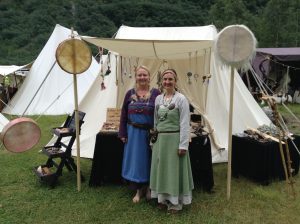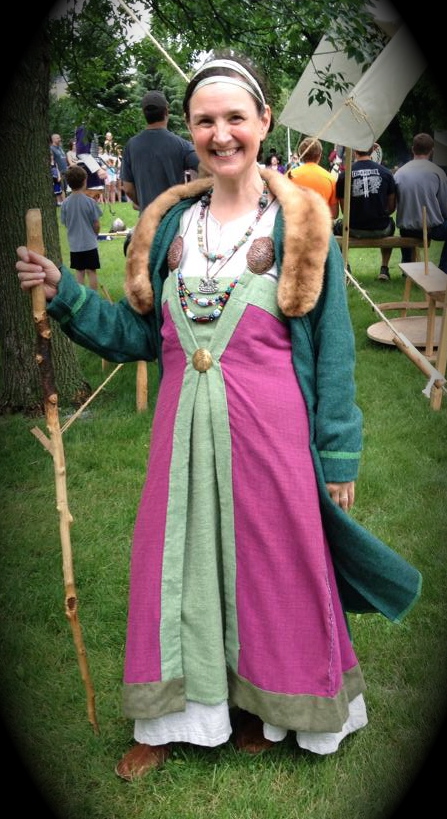We frequently receive questions about Viking-era clothing. So we took this opportunity to ask guest blogger and Nordic Roots educator Kari Tauring to clarify what the Vikings really wore (hint: The folks at the History Channel have really taken some liberties in their conception of the era’s clothing) and to share an opportunity for a unique workshop on historical clothing.
Cultural identity for a Norwegian-American generally relies on a few easily identifiable things. We eat potato lefse, wear Norwegian sweaters, and say Uff Da in the appropriate places. These were things I took for granted, until I was preparing to go on my adventure to Gudvangen, Norway to become part of the Viking Market last Summer. As part of the village, I needed food, clothing, and accessories that would have been able to exist between 750 and 950 ACE. Well, immediately that leaves out potato lefse!
I began to go to the Dragtuvlag (Folk Costume Club) at the Danish American Center where I knew there were wise women with books that could help me figure it out. Additionally, Kelsey Patton was part of the group and she had been doing Viking re-enactment for several years. The first meeting I brought my basket of material and asked, “Would this work? Would this work?” I have to say that this experience led to something of an identity crisis. They didn’t have fast black dye at that time so no black wool is allowed. They also didn’t have the bright red dye. So in essence, the Norwegian national costume of black wool skirt and red wool vest was completely out!
“Well at least I can wear my Norwegian sweater,” I said. There was a sort of sad and uncomfortable look on the faces staring back at me. Then Kelsey revealed that they, didn’t have sweaters. There was no knitting, only nålbinding, and there is no evidence of making garments larger than mittens, hats, and neck warmers with this technique.
Honestly I had to sit down. They stayed warm with their wool garments, coats and shawls. I suppose I should have realized that these Norwegian identifiers didn’t exist at that time, after all, it wasn’t even called Norway at that time! What I found out was that my pale green, bright pink, and indigo blue were favorite colors of the Viking Era, for men and women both! There is a huge array of yellows, reds (but not the bright vest red), oranges, blues, and greens to choose from. This was actually a very colorful time!
I made an un-dyed linen særk (shirt – with length its a shirt dress) and a green hangerok (apron dress) with a pink open front apron dress for “fancy” wear. In addition, Kelsey made me a green wool “kaftan coat” from some beautiful material a friend gave me. This and a pair of leather slippers I found at Savers and I was ready to go. The only thing left was for me to figure out how to say Uff Da in Old Norse (there is no direct equivalent!) I wound up wearing the apron dress with other tops and linen pants underneath throughout my whole five weeks in Scandinavia. I wear it as a skirt some times too. It’s such a convenient and attractive garment that I made a second one in a darker green and wear it often (sometimes even with my Norwegian sweater).


I am complimented on these garments so often that I wanted to support a workshop with Kelsey (who since moved back to her home town in Nebraska) so that others can learn how to make them, what kind of seam treatments they had back then, and really get into the mindset of our deep ancestors of the Northlands. The særk is such a basic garment that it dates from the Bronze Age and has remained basically un-changed into the Immigrant Era. Similarly, the apron dress has a timeless look and can be worn effectively for any era.
Let me assure you that I went into this process only having the basic sewing skills taught to me thirty some years ago by my mother and my Junior High Home-Ec teacher. But working with the linen weave, working with the wool, thinking about what it took to create a full garment nearly 2,000 years ago, really put me into deep respect and communion with my ancestors that no amount of lefse could ever achieve.
– Kari Tauring
Reblogged this on Green Dragon's Cave, Author and Artist and commented:
Viking clothing – a brief history and an upcoming opportunity
We frequently receive questions about Viking-era clothing. So we took this opportunity to ask guest blogger and Nordic Roots educator Kari Tauring to clarify what the Vikings really wore (hint: The folks at the History Channel have really taken some liberties in their conception of the era’s clothing) and to share an opportunity for a unique workshop on historical clothing.
More at the original article:
Many thanks!